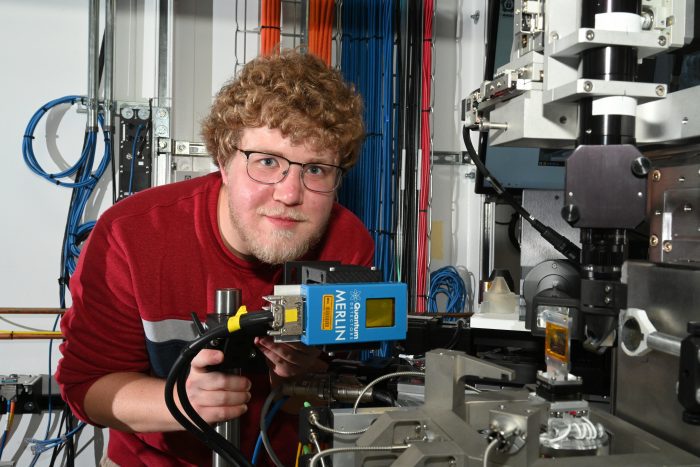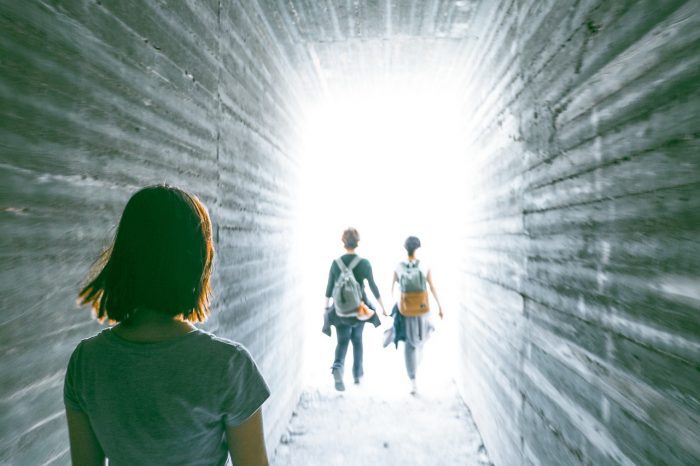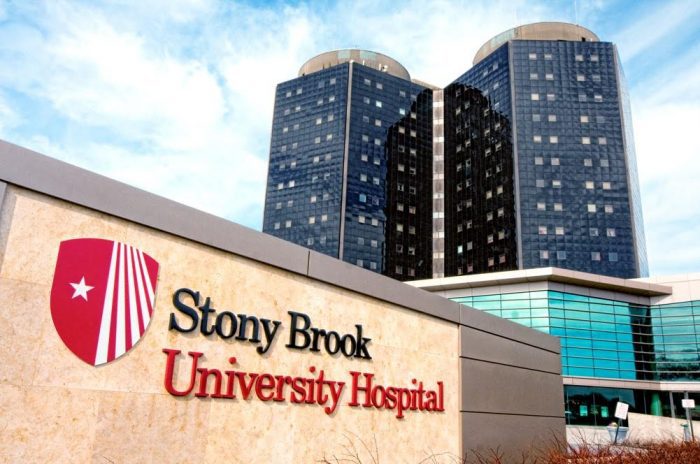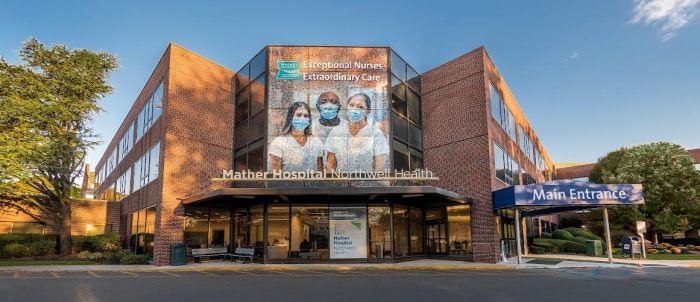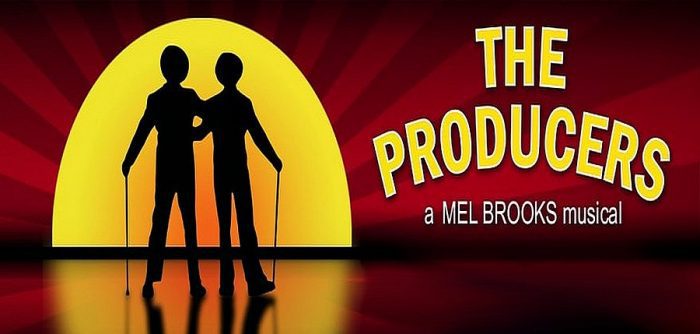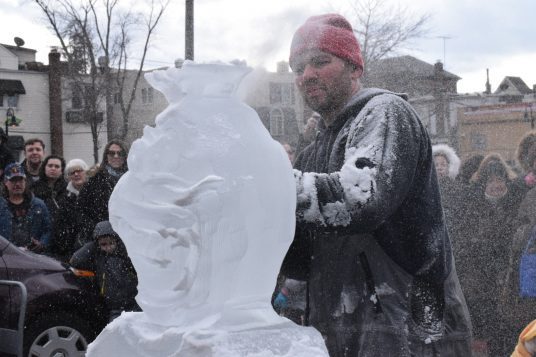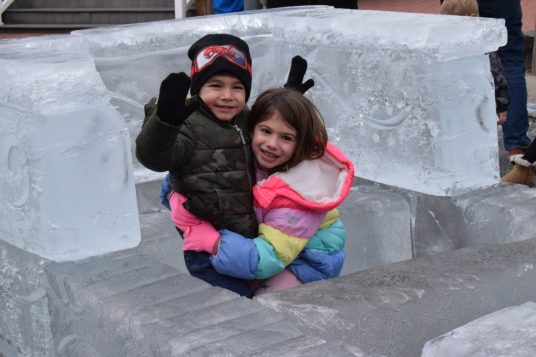Join the Northport Historical Society, 215 Main St., Northport for a Victorian Valentine’s Day on Thursday, Feb. 8 at 7 p.m. Make your date night, Gal-entine’s, or early Valentine’s Day celebration unforgettable! Education Coordinator Carol Taylor takes you on a journey from the beginning of Valentine’s Day to modern times while learning (and sampling) wine paired with handcrafted chocolates. Your evening concludes with a gift provided by Nite Owl Promotions. Tickets are $60, $50 members and must be purchased in advance at www.northporthistorical.org. Ages 21+ only. Questions? Call 631-757-9859.
BNL’s SRX beamline helps scientists and played important role for veterans
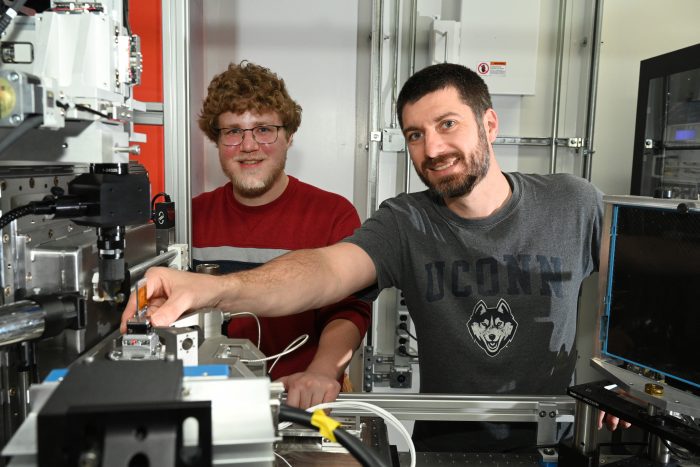
By Daniel Dunaief
When he took over to lead the sub micron resolution X-ray spectroscopy, or SRX, beamline at Brookhaven National Laboratory on January 1, 2020, Andrew Kiss expected to balance between improving the machinery and helping visiting scientists use it. The pandemic, however, altered that balance.
BNL received components for the beamline in December 2019, when the researchers were going to try to take a fraction of the available x-ray time to install and commission it, all while still running experiments. The pandemic, however, kept scientists from visiting the site. That meant Kiss and his colleagues could dedicate more time to technical enhancements.
“Since the pandemic shut down the user program, this gave us an opportunity to focus all of our time on the new equipment” that visiting researchers could tap into when they returned, he explained in an email.
The beamline, which postdoctoral researcher Evan Musterman is enhancing further with diffraction techniques to reveal information about strain (see related story here), is in high demand. During the current cycle, 324 researchers applied for beamline time, while 99 time slots were allocated.
Scientists have a range of ways of discovering which beamline might best suit their research needs, including word of mouth. Kiss has had conversations with researchers who describe how they read something in a research paper and have similar goals.
Scientists “usually have a good idea of what instrument/ facility to use and why it is good for their research so informal conversations at conferences and seminars can be very useful,” Kiss said.
Most of Kiss’s time is dedicated to ensuring the stability and reliability of the beamline, as well as extending its capabilities to scan larger regions with less overhead, he explained.
“All of this is to help the researchers that come to the beamline, but my hope is that with this baseline of reliable and fast data acquisition, I can focus more on scientific topics such as metal additive manufacturing,” Kiss wrote.
With the SRX, Kiss can explore applied questions related to corrosion effects or how a material is modified by exposure to different gases, liquids or other parameters.
Working at the beamline has given Kiss an unusual perspective outside the lab. A few years ago, he received a notification about a recall on baby food he purchased that could have elevated levels of something unhealthy in it. His second thought, after making sure he didn’t give any to the child, was to wonder how much was in the food and if he could measure it. Before he could bring it to the lab, the contaminated food was already taken away with the garbage.
Kiss enjoys his work and suggested that the field attracts a “certain type of person and, once you are there, it is tough to pull yourself away from the instrument and the community of researchers around you,” he explained.
In addition to making basic discoveries in fields such as materials science, Earth science and biological sciences, the SRX beamline has played an important role in studies that have affected public policy.
Indeed, a study in 2022 showed that veterans who worked in Iraq and Afghanistan near burn pits had oxidized particles of iron and titanium in their lungs. “This is not direct evidence it came from a burn pit, but these were not seen in healthy lungs,” Kiss said. Only a few places in the world had the kind of machinery with a bright enough source and high enough resolution to discover these particles.
Kiss and collaborators from other laboratories, universities and medical institutions appreciated the opportunity to have a “positive impact on these soldiers’ lives by providing the measurements to get them help,” he said. The discovery of these elements in the lungs of veterans who lived near burn pits and suffered health consequences, which the study at SRX and other facilities helped demonstrate, led to the Pact Act, which President Joe Biden signed into law in 2022 and which provides $280 billion in federal funding for the health effects veterans suffer after exposure to such toxins.
SRX has high spatial resolution and is highly sensitive to trace concentrations for elemental mapping and chemical composition. SRX is an x-ray fluorescence microscope with “high spatial resolution and highly sensitive to trace concentrations for elemental mapping and chemical composition,” Kiss said. “If that can be used to help people’s lives, that is a wonderful thing.”
Evan Musterman goes from visiting scientist to postdoctoral researcher at BNL
By Daniel Dunaief
It’s everywhere, from holding the water we drink to providing a cover over the Norman Rockwell painting of “The Three Umpires” to offering a translucent barrier between our frigid winter backyards and the warm living room.
While we can hold it in our hands and readily see through it, glass and its manufacture, which has been ongoing for about 4,000 years, has numerous mysteries.
Indeed, given enough temperature and time, glass crystallizes. Controlling the process has been used to increase strength and chemical durability, tailor thermal properties and more over the last several decades.
Evan Musterman, who studied the way lasers served as a localized heat source to induce single crystal formation in glass when he was a graduate student at Bethlehem, Pennsylvania-based Lehigh University, joined Brookhaven National Laboratory in September as a postdoctoral researcher.
Musterman, who received funding for nine months at the end of his PhD program through the Department of Energy’s Office of Science Graduate Student Research program when he was at Lehigh that enabled him to work at BNL, is adding scanning x-ray diffraction mapping as a more user-ready technique at the Submicron Resolution X-ray Spectroscopy beamline (or SRX) that he used as a graduate student.
The beamline looks at x-ray fluorescence measurements, which provide information about the elemental distribution and chemical information, such as oxidation state and bond distances, in an experimental sample. The next component scientists are looking for is using diffraction to inform the crystal structure of the material and to gather information about strain, explained Andrew Kiss, the lead beamline scientist for the SRX.
Musterman hopes to build on the electron diffraction mapping he did during his PhD work when he studied the crystals he laser-fabricated in glass. X-rays, he explained, are more sensitive to atomic arrangements than electrons and are better at mapping strain.
Musterman’s “background in materials science and crystal structures made him an excellent candidate for a post-doc position,” Kiss said.
The SRX has applications in material science, geological science and biological imaging, among other disciplines.
Glass questions
For his PhD research, Musterman worked to understand how glass is crystallizing, particularly as he applied a laser during the process. He explored how crystal growth in glass is unique compared with other methods, leading to new structures where the crystal lattice can rotate as it grows.
Musterman finds the crystallization of glass ‘fascinating.” Using diffraction, he was able to watch the dynamics of the earliest stages after a crystal has formed. In his PhD work, he used a spectroscopy method to understand the dynamics of glass structure before the crystal had formed.
Musterman started working at the SRX beamline in June of 2022. He was already familiar with the beamline operation, data collection and types of data he could acquire, which has given him a head start in terms of understanding the possibilities and limitations.
In his postdoctoral research, he is developing diffraction mapping and is also finishing up the experiments he conducted during his PhD.
Himanshu Jain, Musterman’s PhD advisor at Lehigh who is Professor of Materials Science and Engineering, was pleased with the work Musterman did during his five years in his lab. Jain sees potential future extensions and applications of those efforts.
Musterman’s research “forms a foundation for integrated photonics, which is expected to revolutionize communications, sensors, computation and other technologies the way integrated circuits and microelectronics did 50-60 years ago,” Jain explained in an email. The goal is to “construct optical circuits of single crystal waveguides in a glass platform.”
Musterman’s work “showed details of these optical elements made in glass by a laser,” he added.
Jain, who is an alumnus of BNL, indicated that his lab is continuing to pursue the research Musterman started, with his former graduate student as a collaborator and guide.
Musterman appreciates the opportunity to work with other scientists from different academic and geographic backgrounds. In addition to working with other scientists and helping to refine the functionality of the SRX beamline, he plans to continue glass and glass crystallization research and their interactions with lasers. As he refines techniques, he hopes to answer questions such as measuring strain.
As glass is heated, atoms form an ordered crystalline arrangement that begins to grow. The nucleation event and crystal growth occurs at the atomic scale, which makes it difficult to observe experimentally. Nucleation is also rare enough to make it difficult to simulate.
Most theories describe crystal nucleation and growth in aggregate, leaving several questions unanswered about these processes on single crystals, Musterman explained.
As they are for most material processing, temperature and time are the most important factors for glass formation and glass crystallization.
Historically, studies of glass structure started shortly after the discovery of x-ray diffraction in 1913. In the 1950’s, S. Donald Stookey at Corning discovered he could crystallize glass materials to improve properties such as fracture resistance, which led to a new field of studies. Laser induced single crystal formation is one of the more recent developments.
Musterman and his colleagues found that laser crystallization does not always produce the same phase as bulk crystallization, although this is an active area of research.
Musterman created videos of the earliest stages of crystal growth under laser irradiation by direct imaging and with electron and x-ray diffraction.
Kiss anticipates that Musterman, who is reporting to him, will build infrastructure and understanding of the detection system in the first year, which includes building scanning routines to ensure that they know how to collect and interpret the data.
Once Musterman demonstrates this proficiency, the beamline scientists believe this expanded technical ability will interest scientists in several fields, such as materials science, energy science, Earth and environmental science and art conservation.
Pitching in with former colleagues
While Musterman is not required to work with other beamline users, he has helped some of his former colleagues at Lehigh as they “try to get their best data,” he said. He has also spoken with a scientist at Stony Brook University who has been collecting diffraction data.
A native of Troy, Missouri, Musterman lives in an apartment in Coram. When he was younger, he said science appealed to him because he was “always curious about how things worked.” He said he frequently pestered his parents with questions.
His father John, who owns a metal fabrication and machining business, would take various ingredients from the kitchen and encourage his son to mix them to see what happened.
As for the future, Musterman would like to work longer term in a lab like Brookhaven National Laboratory or in industrial research.
Plain Talk: Hope still lives in 2024
By Fr. Francis Pizzarelli
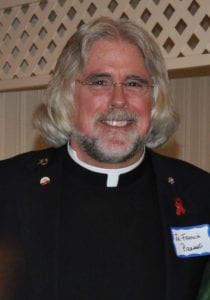
As 2024 unfolds, we find ourselves at war in the Middle East and in the Ukraine. Tens of thousands of innocent people have been slaughtered because of hate.
We have people running for public office peddling the election lie, demeaning and name-calling fellow Americans who are also running for public office. The people in power sit in silence and by their silence they affirm it’s okay to peddle lies and hatefully assassinate another person’s character.
In the religious community, many of our major religious leaders keep silent and are complicit, making excuses for those who hate and have no respect for the human person.
Congress is paralyzed. They were elected to lead and for the most part are frozen in place and distracted by nonsense, instead of really doing the people’s business.
COVID has impaired our educational system. The next generation of college students are ill prepared to continue higher education. Many don’t even know what a declarative sentence is. They possess very weak critical thinking and writing skills. On some levels, we as educators have failed them. We must do things differently.
They have little or no interest in civics, or on becoming the next generation of public leaders. They are more fixated on their cell phones and their social media platforms.
Every semester I ask my freshman at St. Joseph’s University and Suffolk County Community College how many would be willing to hand in their cell phone for the semester. The reaction is unfortunately predictable. You would think I was asking for a kidney. Last semester not one student was willing to take the risk and do this.
As a student of human behavior, I have seen a steady increase in student isolation, student disconnectedness, anxiety, and depression. When I raised these observations, they affirmed what I was seeing. I asked why? They said COVID, cellular technology intensified their insecurity and their fear of reaching out and honestly not knowing how to do it!
However, hope still lives. Those same students indicated that they wanted to make a difference in the world. They wanted to feel and strengthen their human connectedness. I am cautiously optimistic with the right support and education their human connectedness will grow and be strengthened.
They are our next generation of leaders, teachers, social workers, law enforcement professionals, and healthcare professionals just to name a few of the professions before them. We need this generation to recapture compassion, service and the desire to make the world a better place. I am hopeful that they will do a better job than we did.
Father Francis Pizzarelli, SMM, LCSW-R, ACSW, DCSW, is the director of Hope House Ministries in Port Jefferson.
Shelter Cat of the Week: Taco Belle
MEET THE GORGEOUS TACO BELLE!
Can Purr-fection come in a cuter package? We think not … This lovable female Persian mix at the Smithtown Animal Shelter is approximately eight years young (estimated birthdate: 2015) and was found emaciated at her namesake; Taco Bell. She is outgoing, affectionate, vocal and a full-time love machine.
When she first arrived at the shelter she had severe tummy issues. However, the Smithtown Animal Shelter has her gastrointestinal issues down to science, which can be managed through a restricted diet. As a result, her hair has grown lush and thick, she has packed on weight and is ready for a family to adore her around the clock.
Taco Belle is outgoing and loving with everyone and would do well in a home with kids, other cats and even dogs. She is just learning how to properly use a litter box and does have accidents from time to time. The staff at the shelter are hoping to find her a good home that can be patient through the learning process.
If you are interested in meeting Taco Belle, please fill out an application to schedule time to properly interact with her in a domestic setting.
The Smithtown Animal & Adoption Shelter is located at 410 Middle Country Road, Smithtown. Visitor hours are Monday to Saturday from 10 a.m. to 3 p.m. (Sundays and Wednesday evenings by appointment only). For more information, call 631-360-7575 or visit www.townofsmithtownanimalshelter.com.
Stony Brook University Hospital named among America’s 50 Best Hospitals
For the second year in a row, Stony Brook University Hospital (SBUH) has achieved the highest level of national recognition as one of America’s 50 Best Hospitals from Healthgrades, a leading resource that evaluates approximately 4,500 hospitals nationwide. This achievement places SBUH among the top 1% of hospitals nationwide reflecting its commitment to exceptional patient care. SBUH is the only hospital on Long Island to be ranked among the 50 Best Hospitals. As part of this ranking, Stony Brook Southampton Hospital also shares in this recognition.
“Stony Brook’s steady increase in rankings — from the top 250 since 2015, to the top 100 since 2019, and now the top 50 for two years in a row is a reflection of our steadfast commitment to bring the best in care to our patients,” says William A. Wertheim, MD, MBA, Interim Executive Vice President, Stony Brook Medicine.
“The exceptional care found at Stony Brook is only possible when a hospital commits to the highest standards of quality and continuous improvement throughout the organization,” says Carol A. Gomes, MS, FACHE, CPHQ, Chief Executive Officer, Stony Brook University Hospital. “I am grateful to our physicians, nurses and all our healthcare professionals for their dedication to excellence.”
To determine the top hospitals for 2024, Healthgrades evaluated risk-adjusted mortality and complication rates for more than 30 conditions and procedures at approximately 4,500 hospitals nationwide. The 2024 Healthgrades analysis revealed significant variation in hospital performance, making it increasingly important to seek care at top-rated programs. From 2020-2022, if all hospitals, as a group, performed similarly to America’s 50 Best Hospitals, 176,124 lives could potentially have been saved.
“Healthgrades commends Stony Brook University Hospital for their leadership and continued dedication to high quality care,” says Brad Bowman, MD, Chief Medical Officer and Head of Data Science at Healthgrades. “As one of America’s 50 Best Hospitals, Stony Brook University Hospital is elevating the standard for quality care nationwide and ensuring superior outcomes for the patients in their community.”
Stony Brook University Hospital has also been recognized with national Healthgrades Excellence Awards, five-star (the highest level) national ratings and New York State top five rankings for several specialties.
- Cardiac Care Excellence Award™ (2015-24) and Five-Star Distinction for Heart Attack (2022-24) and Heart Failure (2014-24)
- Neurosciences Excellence Award™ (2016-24) and Ranked #2 in New York State for Neurosciences (2024)
- Cranial Neurosurgery Excellence Award™ (2020-24) and Five-Star Distinction (2020-24) for Cranial Neurosurgery (2020-24)
- Stroke Care Excellence Award™ (2016-24), Five-Star Distinction for Treatment of Stroke (2015-24) and Ranked #2 in New York State for Stroke Care (2024)
- Gastrointestinal Care Excellence Award™ (2024), Five-Star Distinction for Treatment of GI Bleed (2024) and Ranked #4 in New York State for Gastrointestinal Medical (2024)
- Critical Care Five-Star Distinctions for treatment of sepsis (2015-24), pulmonary embolism (2024) and Respiratory Failure (2021-24)
To learn more about how Healthgrades measures hospital quality and access a patient-friendly overview of how Stony Brook rates, visit Healthgrades.com.
Holtsville Hal’s famous prediction to be revealed on Groundhog Day

By Heidi Sutton
Pennsylvania may have the legendary groundhog, Punxsutawney Phil, but here in Suffolk County we have our very own prognosticator of prognosticators, Holtsville Hal. The cute little rodent with his buck teeth and short bushy tail will be the star of the day as the Holtsville Ecology Site and Animal Preserve celebrates Groundhog Day with a special event on Feb. 2.
Hundreds will gather to hear Brookhaven Highway Superintendent Daniel P. Losquadro announce Holtsville Hal’s famous forecast.
According to tradition, if a groundhog sees its shadow after stirring from hibernation on Groundhog Day, there will be six more weeks of winter weather; if not, spring should arrive early. Superintendent Losquadro will reveal Hal’s prognostication at approximately 7:25 a.m.
“Our annual Groundhog Day celebration is an enjoyable tradition for many local families,” said Superintendent Losquadro in a press release. “I’m always hopeful Hal will predict an early spring to help my snow removal budget, but either way this is a much-anticipated event each year in Brookhaven Town.”
Although he’s sure to be the center of attention, Holtsville Hal will not be the only animal available for viewing on Feb. 2. Following the ceremony, residents are welcome to enjoy complimentary hot chocolate, coffee and bagels provided by 7-Eleven and Bagel Lovers and visit the more than 100 non-releasable, wild or injured animals residing at the Animal Preserve, including its latest resident, Leonardo “Leo” DiCatprio, the Eurasian Lynx.
The Preserve is also home to a buffalo, black bear, bobcat, coatamundi, hybrid wolves, an artic fox, goats, horses, pigs, cows, alpaca, deer and many more.
Gates will open at the Holtsville Ecology Site & Animal Preserve, 249 Buckley Road, Holtsville, at 7 a.m.; parking is free. Residents are asked to arrive as close to 7 a.m. as possible to get a good view of Hal. Call 631-451-5330 for more information.
Mather Hospital in Port Jefferson named one of America’s 250 Best Hospitals
Mather Hospital in Port Jefferson announced on Jan. 23 that it is one of America’s 250 Best Hospitals for 2024, according to new research released by Healthgrades, a leading resource consumers use to find a hospital or doctor. This achievement puts Mather Hospital in the top 5% of hospitals nationwide for overall clinical performance and reflects Mather Hospital’s commitment to exceptional patient care. Mather Hospital has received the America’s 250 Best Hospitals Award for two years in a row (2023-2024).
“This recognition highlights Mather Hospital’s commitment to clinical excellence and patient safety,” said Executive Director Kevin McGeachy. “Together with Northwell Health we are continually investing in the future of health care for our communities, from recruiting the highly skilled physicians, the construction of our new advanced Emergency Department, and our commitment to advanced technology such as robotically assisted surgical systems. Congratulations to the entire Mather team for this achievement.”
To determine the top hospitals for 2024, Healthgrades evaluated risk-adjusted mortality and complication rates for more than 30 conditions and procedures at approximately 4,500 hospitals nationwide. Unlike other hospital studies, Healthgrades ratings are based solely on what matters most: patient outcomes. The 2024 Healthgrades analysis revealed significant variation in hospital performance, making it increasingly important to seek care at top-rated programs. From 2020-2022, if all hospitals, as a group, performed similarly to America’s 250 Best Hospitals, on average, 178,402 lives could potentially have been saved.*
“Healthgrades commends Mather Hospital for their leadership and continued dedication to high quality care,” said Brad Bowman, MD, Chief Medical Officer and Head of Data Science at Healthgrades. “As one of America’s 250 Best Hospitals, Mather Hospital is elevating the standard for quality care nationwide and ensuring superior outcomes for the patients in their community.”
Consumers can visit Healthgrades.com to learn more about how Healthgrades measures hospital quality and access a patient-friendly overview of how we rate and why hospital quality matters here.
*Statistics are based on Healthgrades analysis of MedPAR data for 2020 through 2022 and represent three-year estimates for Medicare patients only. Click here to view the complete 2024 America’s Best Hospital Awards Methodology.
Theatre Three to hold open cast call for ‘The Producers’
Theatre three, 412 Main St., Port Jefferson will hold ensemble auditions for its upcoming production of The Producers on Sunday, Feb. 18 at 10 a.m. and Monday, Feb. 26 at 7 p.m. Seeking strong singers/dancers to play usherettes, show girls, storm troopers, street characters and more. Prepare 16 bars from the song of your choice; bring sheet music in the proper key; accompanist provided. You may sing from the score. Be prepared to dance. Tap a plus (bring tap shoes if available). Bring headshot/resume if available. Callbacks TBD. Rehearsals begin in March and performances will be held from May 18 to June 22. For more information, visit www.theatrethree.com/auditions.html.
Ice, ice baby! Port Jefferson’s 5th annual Ice Festival is going to be really cool
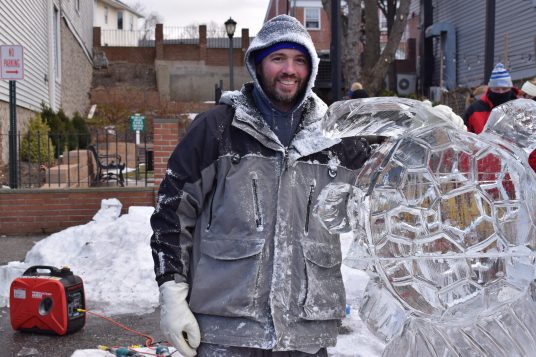
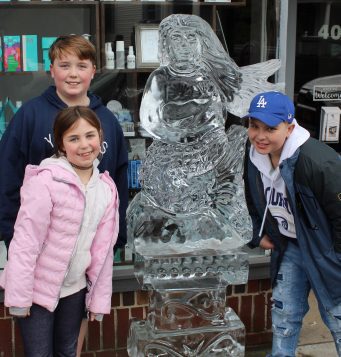
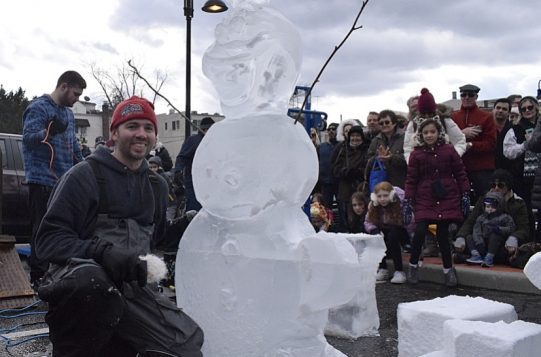
Update: Because of the rain on Sunday, January 28, the second part of the Port Jefferson Ice Festival will be held on Sunday, February 4 from noon to 5 p.m.
By Julianne Mosher
Back by popular demand, the fifth Annual Ice Festival is heading back to the Village of Port Jefferson on January 27 and 28 from noon to 5 p.m.
Hosted by the Port Jefferson Business Improvement District (BID) in partnership with the Greater Port Jefferson Chamber of Commerce, the festival is a fan favorite that bring hundreds in to admire and pose alongside handcrafted ice sculptures created by Guinness Book World Record holder ice carver Rich Daly.
But that’s not all. According to Barbara Ransome, director of operations at the Port Jefferson Chamber, there will also be a new horse-drawn wagon available for rides (fee) and the now-sold-out Mac and Cheese Crawl.
Visitors can enjoy live music, performances by local Shine Dance Company, ice skating demos at the Rinx as well as character photo opportunities and interactive games (cornhole, bowling and tic tac toe) — made out of ice, of course.
Daly, who has been the star of the festival throughout its entire run, said that this year will be “bigger and better than ever.”
“We have about 200 blocks of ice ready for both days,” he said. “And while the ice is awesome, there are a lot of activities for families to do in Port Jeff, so it’s a great event.”
Daly said that on Saturday alone, there will be about 30 sculptures around town outside different Port Jeff shops. Sunday there will be another set ready to photograph with.
And these are not small statues. The famed interactive graffiti ice wall set up in the Frigate parking lot stands large enough for a whole family to pose with, but what’s most fun to watch are the live ice carvings done by Daly in the flesh.
On both days, there will be three live ice carvings starting at 12 p.m. at Mill Creek Road, 2 p.m. at the Meadow Parking Lot and 4 p.m. at Pocket Park. Each carving lasts at minimum an hour.
As founder of Ice Memories Inc. based out of Mastic, Daly is one of only eight certified master carvers in the U.S. Since starting Ice Memories in 2000, Daly has won over 200 ice carving competition titles and received the Guinness World Record for carving 60 ice sculptures in under three hours.
Compared to previous festivals which included Olaf from Frozen, a turtle and a lighthouse, “There will be new characters this year like Spider-Man and Barbie,” Daly said. However, this won’t be your typical doll-sized blonde fashionista.
“She’s going to be a big girl,” Daly laughed. “She’ll be about 6-feet-tall and start off at 2,400 lbs of ice.”
A rain date is set for Feb. 3 and 4. The event and parking are free for both days. For a full schedule and map of events, visit www.portjeffchamber.com. For further information, please call 631-473-1414.



